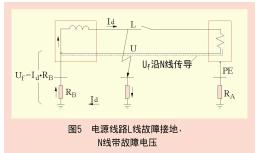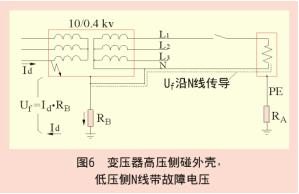Low-voltage lines and electrical equipment often experience leakage current to the ground. This current returns to the transformer's neutral point through the grounding pole of the substation, creating a voltage drop at the grounding point. As a result, both the transformer’s neutral point and the neutral line may carry a few volts, which is considered normal. However, if this voltage rises to tens or even hundreds of volts, it typically indicates an electrical fault, which can lead to serious accidents during maintenance work.
There are several reasons why the neutral line might develop a fault voltage. For example, in the overhead distribution line shown in Figure 5, if a phase line comes into contact with the iron crossarm due to damage to the insulator, a fault current (Id) will flow through the grounding resistor (RB) at the transformer’s grounding pole, causing a voltage drop (Vf = Id × RB) across the resistor, which results in a fault voltage on the neutral line.

Grounding faults on the high-voltage side of the substation can also cause a voltage to appear on the low-voltage side’s neutral line. As illustrated in Figure 6, if the high-voltage winding of the transformer penetrates the outer casing, or if the high-voltage busbar experiences a ground fault due to rodents or snakes, a fault current (Id) will flow through the grounding resistor (RB), resulting in a voltage drop that affects the low-voltage neutral line. This is because, in China, the protective ground of the substation and the grounding of the low-voltage system share a common grounding pole.

In addition to power frequency fault voltages, the neutral line can also be affected by lightning-induced transient surges. These surges can pose a risk to electrical workers, potentially causing damage or injury during maintenance activities. Therefore, it is crucial to monitor and manage these conditions to ensure safety and prevent unexpected failures.
The typical Electrical Wire harnesses that ETOP supplies include dozens of wires and sometimes hundreds of different components and terminations. Our engineering staff is well versed in the design and construction of wire harnesses and is available to assist in the development of the most efficient wiring harness to meet your demands. A basic Wire Harness may include as few as three discreet components, while the more classic harnesses include many more wires and other passive, and potentially active, components.
Electrical Wiring Harness, terminal wiring, wire assembling,bullet terminals, lead wire assembly
ETOP WIREHARNESS LIMITED , https://www.etopwireharness.com